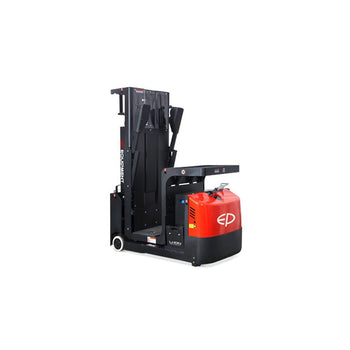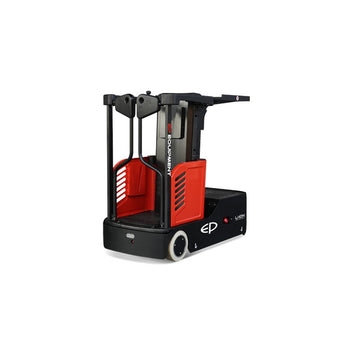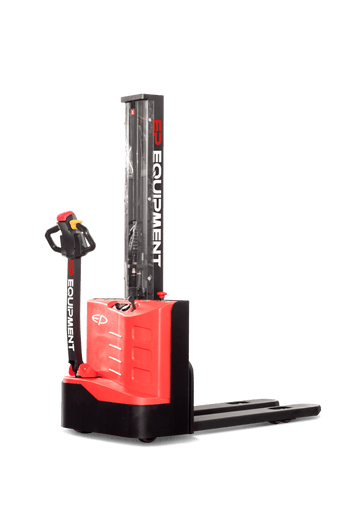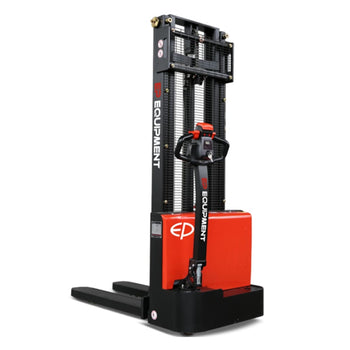Introduction
The boom in e‑commerce and the push for more efficient warehouse operations have encouraged businesses to rethink how they pick and move goods. While traditional forklifts excel at moving pallets and bulk loads, they are less suited to retrieving individual items from high shelves. This task often called “order picking” is increasingly handled by specialised equipment. Order picker forklifts, sometimes referred to as stock pickers or order selectors, combine the manoeuvrability of a pallet truck with a lift platform that takes the operator to the merchandise. By allowing staff to safely access multiple rack levels and pick items directly by hand, order pickers help warehouses process orders more quickly and with fewer errors.
This article serves as a beginner‑friendly explainer on what an order picker forklift is, how it works and why businesses invest in these machines. We also examine common types and applications, outline the advantages over conventional forklifts, and highlight where the JX0 and JX1 electric order pickers from iLift UK can make a difference.
What is an Order Picker Forklift?
An order picker is a type of electric forklift designed for hand‑picking individual items from shelving or pallet racking. Conger Industries describes an order picker as material handling equipment used to pick and transport items from shelving or pallet racking to help fill orders in warehouses and distribution centres. Technically, order pickers are classified under Class II (Electric Motor Narrow Aisle Trucks) in the formal forklift system. They are battery‑powered and operated by a person standing on a platform; the platform, forks and pallet all lift together. Manufacturers sometimes call them cherry pickers, stock pickers or warehouse selectors, but the core concept is the same an operator can be raised to different heights to select items directly from storage.
The TCM Forklifts blog further notes that order pickers enable operators to pick individual items in a warehouse at low, medium or high levels and are highly manoeuvrable for compact spaces. Unlike standard counterbalance forklifts that remain at ground level and lift only pallets, order pickers raise both the operator and the load so that workers can retrieve boxes, cartons or components by hand. This design reduces reliance on ladders and scissors lifts and improves ergonomics for staff.
Because order pickers are electric, they are generally quieter and produce no emissions. Power systems typically use 24‑, 36‑ or 48‑volt batteries, and many models integrate lithium‑ion batteries for faster charging and longer run times. For example, iLift’s JX0 order picker uses a 24 V/135 Ah battery and the JX1 uses a 24 V/205 Ah battery, both paired with duplex masts that reach approximately 3 m.
How Do Order Pickers Work?
The basic components of an order picker include a compact chassis with drive and caster wheels, a lifting mast, an operator platform and controls. The Conger article explains that the operator platform contains all the controls steering wheel, lift/lower functions, and sometimes a joystick to move the truck forward, backward and side‑to‑side. A deadman pedal under the platform must be depressed for the machine to operate, enhancing safety. When the truck reaches the desired rack location, the operator uses the controls to raise the platform and forks; some models feature a pallet claw that grips the pallet and prevents it from falling during lifting.
Order pickers are designed to run in very narrow aisles, sometimes less than 1.8 m wide. Conger notes that one of the biggest advantages of order pickers is their ability to work in very narrow‑aisle applications. Compact drive units, centrally mounted traction motors and swivelling caster wheels enable these trucks to pivot within confined spaces. In the Raymond order picker FAQ, the company states that order pickers are appropriate for operations dealing with many stock‑keeping units (SKUs) and low quantities of each SKU, whereas they are not suited for unit‑load picking or right‑angle stacking. Because the operator is elevated during operation, manufacturers require operators to wear a harness and undergo proper training.
Electric order pickers rely on battery power and hydraulic pumps to raise the platform. Some models, like those offered by TCM, employ lithium‑ion batteries and integrate with warehouse management systems to optimise communication between machinery, operators and software. This integration allows real‑time inventory updates and can reduce downtime and total cost of ownership. By eliminating internal‑combustion engines, order pickers produce no fumes, which is especially important in enclosed warehouse environments.

Types of Order Pickers and Their Reach
Order pickers are generally categorised by the height they can reach. Understanding these categories will help you choose the right machine for your facility.
Low‑level order pickers
Low‑level order pickers typically work on the ground or the first rack level. According to TCM, low‑level order pickers have platform elevation heights around 1,000 mm and are ideal for picking from the ground and first tier. They offer rapid acceleration with gentle braking, making them perfect for moving between picking stations. Low‑level machines are common in grocery stores, pharmaceutical warehouses and other operations with high throughput at lower rack heights.
Medium‑ and high‑level order pickers
For taller racking, medium and high‑level order pickers feature masts and platforms that rise much higher. TCM notes that these machines have enclosed cabs that rise up to 11 metres and are used in larger warehouses where companies have a high proportion of SKUs and need to pick across the face of the racking. The ability to lift the operator and pallet several meters into the air maximises vertical space and can reduce the need for additional storage facilities. High‑level order pickers usually require specialised racking and guidance systems such as wire or rail guidance to keep the truck centred in very narrow aisles.
Low‑level order pickers with vacuum lifters
Some manufacturers, such as TAWI, have developed low‑level order pickers with integrated vacuum lifters. TAWI explains that order pickers are fundamentally different from traditional forklifts because they are designed to fulfil individual customer orders rather than move full pallets. These machines suit light‑duty tasks such as horizontal transport, loading and unloading, and replenishing inventory. TAWI’s mobile order picker incorporates a vacuum lifter mounted on an articulating jib arm that reduces physical strain on workers by allowing single operators to lift goods weighing up to 80 kg with minimal effort. This highlights how order picker technology continues to evolve to meet ergonomic and productivity demands.
Advantages of Using Order Pickers
Order picker forklifts provide a number of benefits compared with ladders, scissor lifts or conventional forklifts. Key advantages include:
-
Improved productivity. Because the operator and pallet move together, staff can pick items at multiple heights without repeatedly climbing down ladders. This reduces cycle time and allows workers to maintain a higher throughput, particularly in e‑commerce fulfilment and distribution centres.
-
Narrow‑aisle capability and space utilisation. Conger notes that order pickers can operate in very narrow aisles sometimes as narrow as 1.0 m allowing warehouses to reduce aisle width and add more rack space. By utilising vertical space, order pickers maximise storage density and can defer the cost of facility expansion.
-
Safety and ergonomics. Picking items by hand from ladders or mezzanines exposes workers to falls and musculoskeletal injuries. Order pickers feature guard rails, deadman pedals and harness tie‑downs. According to Conger, the design reduces the risk of injuries associated with manual order picking. Many units also include anti‑roll‑back systems and emergency stop buttons, like those found on iLift’s JX0 pallet truck.
-
Flexibility and manoeuvrability. Order pickers are smaller and more manoeuvrable than most forklifts. They can be driven forward, backward and laterally, allowing operators to navigate tight aisles and reposition easily. Some models include joystick controls for intuitive steering.
-
Electrification and sustainability. As electric machines, order pickers emit no exhaust gases and generate less noise than internal‑combustion forklifts. TCM emphasises that its order pickers use lithium‑ion or lead‑acid batteries and can integrate with warehouse software to reduce downtime and total cost of ownership. Choosing electric models can also help warehouses meet environmental and employee‑health goals.
-
Adaptability to various loads. While order pickers are designed for picking individual items, many can also carry small pallets, totes or roll cages. TAWI notes that order pickers suit tasks such as horizontal transport, loading and unloading, and replenishing inventory, making them versatile.
Who Needs an Order Picker Forklift?
Order picker forklifts are not one‑size‑fits‑all solutions; they excel in specific environments. Raymond notes that they are appropriate for operations with many SKUs but low quantities of each SKU. In warehouses with thousands of product lines such as e‑commerce fulfilment centres, parts distribution hubs, pharmaceutical distributors and retail stock rooms workers must pick items from various heights quickly and safely. Order pickers enable them to do this without carrying full pallets.
Industries that benefit from order pickers include:
-
E‑commerce and third‑party logistics (3PL). Fast order fulfilment and high SKU counts make order pickers indispensable. Employees can retrieve items from high‑bay racking while navigating narrow aisles.
-
Retail warehouses and supermarkets. Stores often hold many SKUs with low on‑hand quantities. Order pickers are used for restocking shelves, picking online grocery orders and retrieving items stored on high racks. TAWI observes that these machines are also useful for horizontal transport, loading and unloading and replenishing inventory.
-
Manufacturing and assembly. In production settings, order pickers help fetch parts or subassemblies stored at height. TCM notes that the ability to pick items at low, medium or high levels and manoeuvre in compact spaces makes them suitable for diverse operations.
-
Pharmaceutical and health‑care distribution. Regulations often require secure storage of pharmaceuticals, leading to high‑bay racking and many SKUs. Order pickers allow staff to retrieve drugs and medical supplies safely.
Conversely, order pickers are not suited for tasks such as unit‑load picking, right‑angle stacking or long‑distance travel. If your operation primarily moves full pallets or heavy loads over long distances, reach trucks, counterbalance forklifts or pallet jacks may be a better fit.

iLift’s JX0 and JX1 Electric Order Pickers
If you are looking to add an order picker to your fleet, choosing a reliable brand matters. iLift UK specialises in lithium‑ion‑powered material‑handling equipment and offers two vertical order pickers designed for productivity and safety: the JX0 and JX1.
JX0 – stable and intuitive for small‑volume picking
The JX0 is described as a new‑generation task support vehicle with an extremely stable mast and an intuitive user interface. iLift lists it with a 24 V/135 Ah battery, a 3,000 mm duplex mast and an overall weight of 90 kg. The JX0 plays out its strengths in smaller‑volume order picking and retail environments, where its compact footprint and stability help workers move confidently at height. Because the operator platform and mast are stable, the JX0 can reduce injuries compared with using ladders or less specialised lifts.
The product FAQ notes that the JX0 pallet truck is designed to handle loads up to 2,500 kg, charges fully in around 4–6 hours, and includes safety features like an anti‑roll‑back function and emergency stop buttons. A lifting height range of 85–200 mm on its pallet truck capability makes the JX0 versatile for moving standard pallets in addition to picking. iLift also emphasises that every JX0 comes with a battery included, a comprehensive Pre‑Delivery Inspection (PDI) and a five‑year battery warranty, giving customers peace of mind. Flexible service contracts help keep the machine running at peak performance over its life.
JX1 – productivity and safety with a larger platform
For operations requiring more platform space and a slightly higher battery capacity, iLift’s JX1 is a strong candidate. It features a 24 V/205 Ah battery, a 3,000 mm duplex mast and a weight of 90 kg. The company describes the JX1 as a vertical order picker that helps increase productivity while reducing the risk of injuries. Its heavy‑duty, stable mast and large working platform provide employees with the safety they need to work efficiently.
The FAQ for the JX1 notes that the pallet truck version has a 2,500 kg load capacity, uses a 24 V lithium‑ion battery that provides several hours of continuous operation, and includes safety features such as an emergency stop button, anti‑slip handlebars and automatic speed reduction when turning. These features make the JX1 suitable for narrow aisles and busy environments. Like the JX0, it comes with battery included, a five‑year battery warranty and a thorough PDI.
Both the JX0 and JX1 are part of iLift’s lithium‑ion equipment range, which emphasises sustainability and reduced downtime. By investing in lithium‑powered order pickers, warehouses can benefit from fast charging, longer battery life and minimal maintenance.
Choosing the Right Order Picker
When selecting an order picker forklift, consider the following factors:
-
Order‑picking heights and aisle widths. Determine the maximum shelf height you need to access and the width of your aisles. Low‑level pickers suffice for first‑tier picking; medium or high‑level pickers may be necessary for multi‑tier warehouses.
-
Load capacity and pallet handling. Ensure the machine can handle the weight of the pallets or totes you plan to lift. Both iLift models handle up to 2,500 kg.
-
Battery type and run time. Lithium‑ion batteries offer faster charging and longer life than lead‑acid. Consider your duty cycle and whether you need opportunity charging during breaks.
-
Integration with warehouse systems. Modern order pickers can interface with warehouse management systems to streamline workflows. If you plan to automate tasks or use voice‑directed picking, ensure compatibility.
-
Ergonomics and safety features. Look for features such as stable masts, guard rails, emergency stop buttons, anti‑slip flooring and comfortable controls. iLift’s models include safety features like anti‑roll‑back and speed reduction.
Conclusion
Order picker forklifts fill a vital niche in modern warehousing. By lifting both the operator and the load, these machines enable fast, safe retrieval of individual items from multiple shelf levels. They are ideal for operations with many SKUs and low quantities per SKU, such as e‑commerce fulfilment, retail distribution, manufacturing and parts supply. The benefits improved productivity, better space utilisation, enhanced safety, and compatibility with narrow aisles make order pickers a smart investment for businesses striving to optimise their warehouses.
If you’re ready to experience these advantages, consider iLift’s JX0 and JX1 electric order pickers. The JX0 offers a compact footprint and intuitive controls that excel in smaller‑volume picking and retail environments, while the JX1 delivers a larger platform and enhanced stability to boost productivity in more demanding applications. Both models come with lithium‑ion power, a five‑year battery warranty and a pre‑delivery inspection to ensure reliability.





